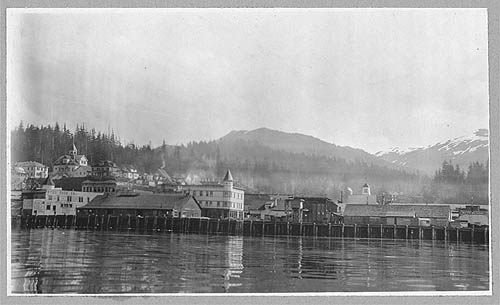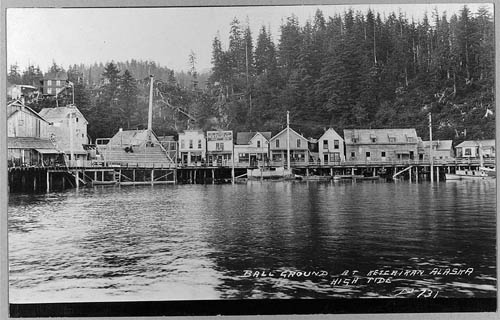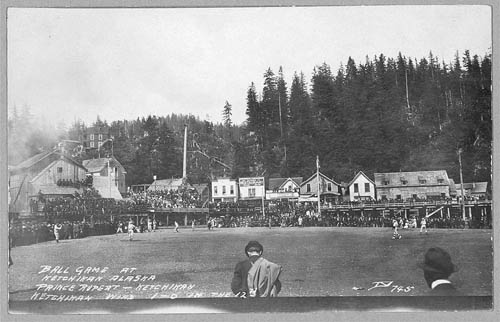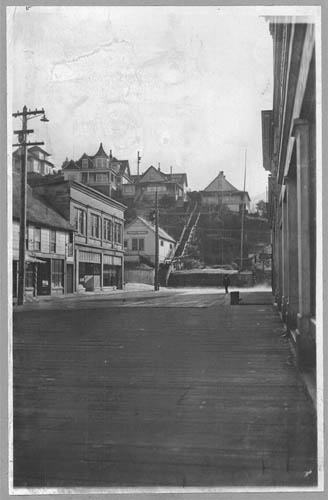 By June Allen August 22, 2002
 Ketchikan, AK [between ca. 1900 and ca. 1930] - Click on photo to view a larger photo. Forms part of: Frank and Frances Carpenter collection (Library of Congress). Gift: Mrs. W. Chapin Huntington; 1951. Historic Photo Courtesy of the Library of Congress Prints and Photographs Division - Washington, D.C. Ketchikan was not alone among the Southeastern Alaska towns founded because of the Alaska Gold Rush of '98 or, in the cases of Ketchikan and Juneau, whose populations numbers had been considerably increased by Gold Rush marine traffic. In fact, there was an informal race of sorts among the Southeastern towns to be first to be officially consolidated. Skagway won that race in June of 1900, edging out competing Juneau by one day; Juneau was already an established gold mining town at the advent of the gold fever years. Ketchikan had been struggling to survive for about a decade when the booming marine traffic along the Inside Passage gave it a chance to succeed. Ketchikan's incorporation in the summer of 1900 was held up for two months - its first petition in June was rejected because it included the signatures of women, not yet qualified to be included. Or so the story goes. Ketchikan petitioned anew in July with all male signatures. And little Ketchikan was possibly smaller than it claimed to be. The 1900 U.S. Census counted 459 legal residents, yet Ketchikan's petition claimed 800 residents! That may have been true on a day when two steamships were docked and their passengers were stretching their legs, in summer, on a sunny day! But the small town on Tongass Narrows was, in any event to grow rapidly and encouragingly in the next decades. Look at a map of Ketchikan today and notice that the entire waterfront from one end of town to the other is a pattern of its neatly geometric contours. Almost every inch is manicured into tidy maritime use. That wasn't so in 1900. Ketchikan creek burbled down through its rocky confines but then fanned out over the wide and sweeping tideflats it had created over thousands of years of grinding away at its rocky banks. Docks to the north of the creek's mouth stood on stork-like legs at low tides. Piling-supported wharves and warehouses, coal sheds and the rear facades of businesses, already-weathered-to-gray, lined the waterfront.  Ketchikan's old ball ground under water at high tide [early 1900s] Click on photo to view a larger photo. Forms part of: Frank and Frances Carpenter collection (Library of Congress). Gift: Mrs. W. Chapin Huntington; 1951. Historic Photo Courtesy of the Library of Congress Prints and Photographs Division - Washington, D.C. Ketchikan's possibilities were probably noticed in the first place because of the wide, sweeping tideflats created at the mouth of Ketchikan Creek. It was a good site for beaching canoes for the Tlingits who had fished the rich salmon stream each summer for centuries. That sweeping beach and salmon stream also caught the eye of cannery interests. One cannery had been moved in the late 1880s from the Boca de Quadra area to Ketchikan's beachfront - about where Downtown Drugstore is today. But after a year's operation, it burned down and was not replaced. A decade later, the year of the petition for incorporation, however, Ketchikan's waterfront was in a process of revolving change that has continued to this day. The 1900 petition for incorporation as a city outlined specifically the infrastructure of the town. In the words of attorney Charley Ingersoll, the lawyer who drew up the petition, Ketchikan was a mining supply center for a large surrounding region of gold and copper mines. The town in 1900 boasted "four large wholesale mercantiles, the largest cannery in Alaska, six saloons, two drug stores, a church, two hotels, four restaurants, two meat markets, two barber shops, a tailor shop, two laundries, two shoe-repair shops, two large halls, the Red Men lodge, two assay offices, a news stand, two wharves, warehouse, boat building shop, offices of the U.S. Commissioner and the U. S. Marshall, a dairy, three law offices, a mining recorder, two dentists, four physicians and a hospital." The U.S. Customs office was also moved to Ketchikan that year, requiring every northbound vessel to stop for inspection. There may be a few exaggerations in that list, but nevertheless, not bad for a town of somewhere between 459 and 800 residents! What they wanted, these founding fathers and voters, was a school for their children, law and order, street improvements sanitary measures, and regulations to promote good order and "local moral and social conditions." Incorporation apparently was the path to the ability to tax, to spend tax dollars and to craft ordinances by duly elected officials that would be beneficial to the people of Ketchikan. And so the election of August 18, 1900, was held. The polls were open from 8 a.m. to 7 p.m. Saloons, dance halls and card rooms were closed that day. The closure of such businesses on all election days continued in Alaska throughout Territorial days. There were 103 votes cast that August day, 82 of them in favor of incorporation as a city, 18 against, and three voters voted for candidates but did not vote on the prime issue of incorporation. It was more than enough. A week later, on August 25, 1900, the legal documents were signed that made Ketchikan a bona fide city. The anniversary of that historical event was heartily celebrated in the First City in the year 2000.  Ketchikan: Ball game with Prince Rupert at low tide [1916] Click on photo to view a larger photo. Forms part of: Frank and Frances Carpenter collection (Library of Congress). Gift: Mrs. W. Chapin Huntington; 1951. Historic Photo Courtesy of the Library of Congress Prints and Photographs Division - Washington, D.C. By that summer of 1900 the nature of the town's shoreline had changed from its original contours, even in such short a time since the town was first settled somewhere around 1890. The high tide waters washing over most of its patch of sandy shore or lapping against the base of the of rocky outcroppings and the base of Nob Hill were no longer visible. They were hidden by the side-by-side docks on which much of the city's commerce was transacted. Except for the Thomas Basin area - which was dredged and made into a small boat harbor three decades after 1900 - those tides still lap the underpinnings and basement facades along the upland side of today's Front Street. Hidden under those downtown docks are KPU utility enclaves, the nesting areas of the town's pigeons - and some of its two-legged vagrants, and the underpinnings of much of the downtown district. By 1900, it was no longer necessary to smuggle illegal liquor into Ketchikan, since saloons had become legal in 1898. But 20 years later the liquor ban was once again in effect via Prohibition, and otherwise law-abiding entrepreneurs found ways to get around that ban on spirits. Picture it: At just the right pre-set time of low tide, skiffs laden with illegal booze slipped silently under the city's docks under cover of darkness, threaded their way among the slimy piling festooned with seaweed streamers and clinging sealife until they were directly under the trap doors of their destination. At a signal. the trap door opened and men above hefted the booze shipment and quietly stored it in one of the many secret caches in Ketchikan's downtown business district. Only six hours by small boat from Canada's Prince Rupert, Ketchikan was known for its fine bootleg liquor.
The downtown area in 1900 smelled of tide-stirred fish waste from the cannery, of raw sewage that fell directly into the tidewater, of coal smoke and kerosene, but also of the sweet fragrance of fresh-sawed spruce and cedar and salt-water winds. There were smells of wet wool and freshly unwrapped oilskins, of greased leather boots, wet plank streets and steamy horseflesh. And new wooden streets and walkways were added and homes built, each a little nicer than the last, and then the wives and children came to join fathers after a school was built, and new businesses opened to accommodate families. Churches were built, and new neighborhoods gradually were opened. Many, probably most of the residents of that summer of 1900 left again, to try their luck elsewhere or to wander south and finally back to where they come from. But some stayed. There are familiar 1900 names still included in today's Ketchikan phone directory. They were joined over the years by others who came after, and stayed. There are still election notices posted and elections held. There's not the excitement and energy of the election of 1900 today, and it seems there's far more pessimism among today's citizens. But Ketchikan was a winner from the day it was founded. And it will continue to survive.
|
||
